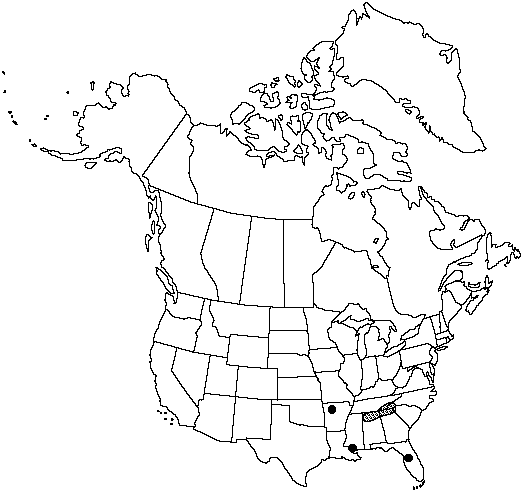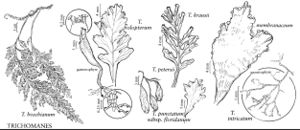Difference between revisions of "Trichomanes petersii"
Amer. J. Sci. Arts ser. 2, 15: 326. 1853.
FNA>Volume Importer |
FNA>Volume Importer |
||
| Line 20: | Line 20: | ||
}}<!-- | }}<!-- | ||
| − | --><span class="statement" id="st- | + | --><span class="statement" id="st-undefined" data-properties=""><b>Plants </b>on rock or epiphytic. <b>Stems</b> long-creeping, threadlike, and intertwining, bearing scattered leaves, covered with dark hairs of 2 types, 2-celled glandular hairs and elongate rhizoidlike hairs; roots absent. <b>Leaves</b> elliptic to oblanceolate, simple, 0.5–2 cm × 2–5 mm, ± entire, bearing simple or 2-cleft dark hairs on margin and 2-celled glandular hairs on petioles and veins; petioles nearly as long as blades. <b>Venation</b> weakly pinnate with numerous unconnected false veins. <b>Soral</b> involucres usually 1 per leaf, terminal on blades, short-conic, flaring widely at mouth; involucre lips not dark edged. <b>Gametophytes</b> composed entirely of branched filaments. <b>Gemmae</b> composed of short filaments of undifferentiated cells. <b>2n</b> = ca. 102.</span><!-- |
-->{{Treatment/Body | -->{{Treatment/Body | ||
| Line 50: | Line 50: | ||
|publication year=1853 | |publication year=1853 | ||
|special status= | |special status= | ||
| − | |source xml=https://jpend@bitbucket.org/aafc-mbb/fna- | + | |source xml=https://jpend@bitbucket.org/aafc-mbb/fna-data-curation.git/src/9216fc802291cd3df363fd52122300479582ede7/coarse_grained_fna_xml/V2/V2_357.xml |
|genus=Trichomanes | |genus=Trichomanes | ||
|species=Trichomanes petersii | |species=Trichomanes petersii | ||
| − | |||
| − | |||
| − | |||
| − | |||
| − | |||
| − | |||
| − | |||
| − | |||
| − | |||
| − | |||
| − | |||
| − | |||
| − | |||
| − | |||
| − | |||
| − | |||
| − | |||
| − | |||
| − | |||
| − | |||
| − | |||
| − | |||
| − | |||
| − | |||
| − | |||
| − | |||
| − | |||
| − | |||
| − | |||
| − | |||
}}<!-- | }}<!-- | ||
-->[[Category:Treatment]][[Category:Trichomanes]] | -->[[Category:Treatment]][[Category:Trichomanes]] | ||
Revision as of 14:18, 27 July 2019
Plants on rock or epiphytic. Stems long-creeping, threadlike, and intertwining, bearing scattered leaves, covered with dark hairs of 2 types, 2-celled glandular hairs and elongate rhizoidlike hairs; roots absent. Leaves elliptic to oblanceolate, simple, 0.5–2 cm × 2–5 mm, ± entire, bearing simple or 2-cleft dark hairs on margin and 2-celled glandular hairs on petioles and veins; petioles nearly as long as blades. Venation weakly pinnate with numerous unconnected false veins. Soral involucres usually 1 per leaf, terminal on blades, short-conic, flaring widely at mouth; involucre lips not dark edged. Gametophytes composed entirely of branched filaments. Gemmae composed of short filaments of undifferentiated cells. 2n = ca. 102.
Habitat: On tree trunks and noncalcareous rocks in deep narrow gorges
Elevation: 0–500 m
Distribution

Ala., Ark., Fla., Ga., La., Miss., N.C., S.C., Tenn., Mexico, Central America in Guatemala.
Discussion
Trichomanes petersii has irregular meiosis and generally misshapen spores, but it produces some large and viable spores, presumably unreduced in chromosome number. Gametophytes, identified as this taxon by enzyme electrophoresis, have been observed to produce apogamous sporophytes. Therefore, the species seems capable of some reproduction by an apogamous life cycle. Sporophytes also reproduce vegetatively by dispersible buds formed on the leaves. Although some gametophytes in the vicinity of sporophytes have been shown to be Trichomanes petersii, most of the independent Trichomanes gametophyte populations of the eastern United States are T. intricatum.
Sporophytes of Trichomanes petersii and other species of subg. Didymoglossum form dense mats of imbricated leaves, often excluding all other vegetation. In this habit, as well as in their reduced size and absence of roots, they have adopted a growth form mimicking and successfully competing with bryophytes. In Louisiana and Mississippi, T. petersii occurs on trunks of Fagus and Magnolia. Elsewhere it is on noncalcareous rocks, but in Florida, T. petersii also occurs on chert boulders in limestone sinks and cliffs.
Selected References
None.
